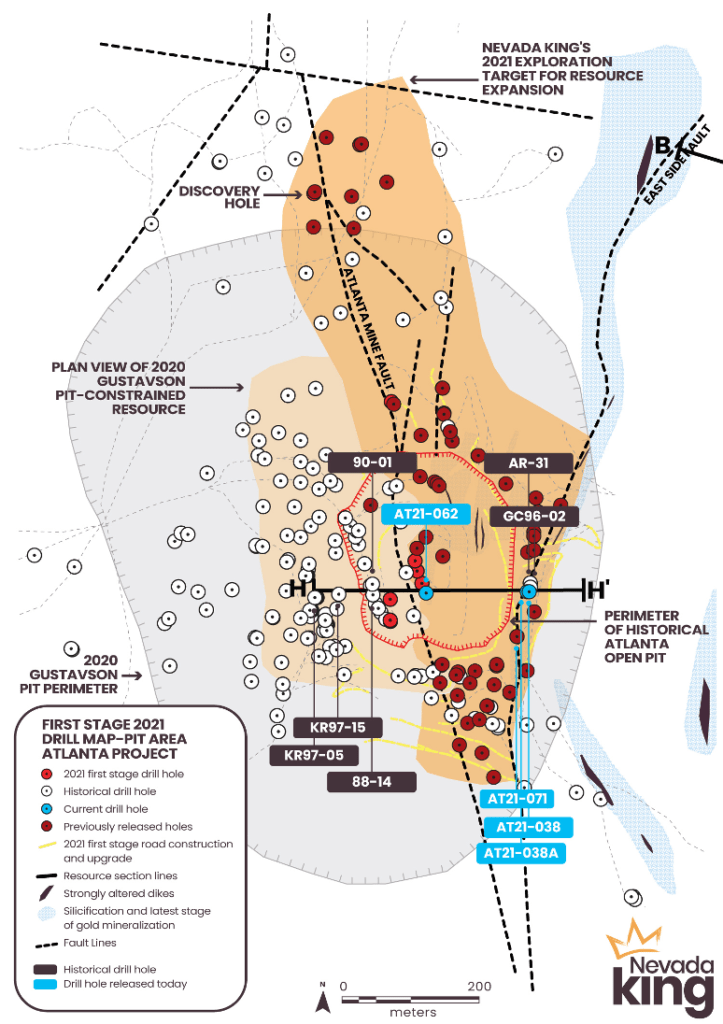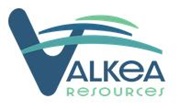NEVADA KING (NKG.V): INTERCEPTS 5.34 G/T OF OXIDE GOLD OVER 54.9 METRES STARTING AT SURFACE IN A HOLE COLLARD WITHIN THE ATLANTA PIT, BATTLE MOUNTAIN TREND, NEVADA
VANCOUVER, BC, January 12, 2022 – Nevada King Gold Corp. (TSX-V: NKG; OTCQX: NKGFF) (“Nevada King” or the “Company”) is pleased to announce that one of its reverse circulation (“RC”) exploration drill holes intercepted 54.9 metres grading 5.34 g/t oxide gold, starting at surface from within the south-west corner of the Atlanta open pit, on its 100% owned Atlanta gold mine project, Battle Mountain Trend, Nevada. This hole is one of several vertical RC holes drilled along the western edge of the pit bottom (Figure 1) in an area that had not been drill-tested since the cessation of mining in 1985.
Highlights
- Vertical RC drill hole AT21-062, drilled from within the Atlanta pit, encountered 54.9m averaging 5.34 g/t Au starting at surface. The mineralized rock is oxide material and includes a high-grade intercept of 10.7m averaging 11.19 g/t Au from 30.5m to 41.2m. The true thickness of the reported intervals are uncertain, however, based on the Company’s initial interpretation of the geometry of the gold mineralization (Figure 2) true thickness of the replacement-type mineralization is expected to be in the range of 70% to 85% of the reported 54.9m intercept length.
- This high-grade intercept projects southward along the Atlanta Mine Fault zone into an area of low historical drill density measuring about 100m long by 50m wide that encompasses only one historical hole. Pit wall instability, lack of access, and the prospect of encountering shallow stopes limited previous exploration drilling in this area to the testing of deeper projected vein targets.
- As a result there is no shallow drill data from prior drilling within this part of the property and gold mineralization in this area is not included in the current Atlanta resource estimate (Gustavson 2020 NI 43-101 pit constrained resource estimate), even though it occurs at surface and within the confines of the Gustavson resource constraining pit shell.
- Similar potential for resource expansion is seen in holes AT21-038 and AT21-038A also reported today and drilled along the eastern margin of the open pit, where both intercepts confirm a 32m-thick zone of near-horizontal mineralization that connects with mineralization sampled along the pit walls (Figure 2).
- Moving forward into 2022, Nevada King will be tracking the shallow high grade mineralization intercepted in AT21-062 with additional drilling stepping out to the south.
Cal Herron, Exploration Manager of Nevada King, stated, “In 1997, Kinross intercepted 38.1m grading 6.69 g/t Au in angle hole KR97-15, located to the west and just beneath today’s high-grade intercept. Kinross never followed up on this high-grade hit and as such, it remained a point anomaly, attributing very little tonnage to the existing resource. Today’s intercept of 5.34 g/t Au over 55m starting at surface is a game-changer, confirming and expanding upon Kinross’ historical hit and demonstrating the strength of the high-grade Atlanta Mine Fault Zone. The Atlanta Mine Fault appears to be a prolific host for high-grade gold, running a known strike length of 1km. Further, this zone is open to the north and south, as well as to depth.”


Drill Results Along Section H-H’ and in the Vicinity
Assay results from Nevada King’s RC drilling along Section H-H’ and within the vicinity are reported below in Table 1. The reported intercepts are down-hole lengths and may not represent true thickness of mineralization. However, the intercepts in vertical holes AT21-62 and AT21-38 may be close to true thickness, but additional drilling is needed for ascertaining the actual geometry of the mineralized zone. Based on nearby Kinross hole KR97-15, the Company is confident that AT21-062 has not drilled down a narrower vein and that the high grade mineralization has significant thickness in this area, again as illustrated in Figure 2. Averaged intercepts utilize a 0.30 g/t external cut-off grade.
Table 1.

Historical angle RC hole KR97-15 (Figure 2) drilled by Kinross in 1997 cut 38.1m grading 6.69g/t Au, including 7.6m grading 12.28g/t from 172.3 to 179.9m. This was one of the shallowest and highest grade gold intercepts within the Gustavson 2020 resource model, but the lack of hole data to the north, east, and south precluded Gustavson from laterally expanding this outstanding intercept, so it remained a point anomaly. Historical RC drilling west and down dip from KR97-15 produced conflicting grade averages that were difficult to rectify with the KR-97-15 intercept. The high grade intervals seen in KR-97-15 are not reflected in the nearby KR-97-05, and more importantly, the 45.7m @ 6.32 g/t reported in vertical Bobcat hole 88-14 cannot be rectified in any way with the 56.4m @ 1.46 g/t returned in the vertical twin hole drilled by Bobcat two years later. The large grade disparities seen in these four historical holes casted doubt on the validity of these reported higher grade intercepts, which in turn made it impossible for Gustavson to merge the high grade in KR97-15 downward into the 88-14 high grade intercept. Similar problems occurred when trying to rectifying gold grade between holes in other parts of the Gustavson resource model, raising the question of whether or not the discrepancies were due to erratic mineralization, drill recovery problems, assay lab problems, or all of the above.
The Company’s ongoing exploration and interpretative work is designed to resolve these questions. With this objective, initial work has included drilling a N-S panel of closely spaced shallow vertical holes above and slightly east of the KR97-15 intercept. AT21-062 was closest to the KR97-14 intercept, both with respect to geography and grade. The 10.7m @ 11.19 g/t in AT21-062 matches closely with the 7.6m @ 12.28g/t reported in KR97-1, which tends to validate the grades and thicknesses seen in both holes. It also lends credence to the high-grade intercept reported by Bobcat in 88-14. Aside from extending the mineralization from KR97-15 up to the bottom of the pit, AT21-062 more importantly confirmed the higher grade mineralization seen in KR97-15 and 88-14, which will figure prominently moving forward into the 2022 drilling program. Nevada King now sees good potential for expanding the shallow, oxidized, higher grade mineralization encountered in AT21-062 both laterally and down-dip to depth from the bottom of the existing pit. This higher grade mineralization now holds promise for establishing early cash flow in the event of an open pit operation. A larger proportion of the 2022 drilling program will consist of core holes dedicated to chasing this shallow, higher grade mineralization along strike and to depth.
Nevada King’s 2021 drilling program at Atlanta was designed to accomplish two primary objectives: (1) expand the Gustavson resource model to the north, south, and east of the historical pit, and (2) determine whether higher grade mineralization seen in deeper portions of the resource model extend upward toward the surface. NKG’s drill holes along Section H-H’ (Figure 2) cleary achieved both objectives. The AT21-062 intercept confirms similar high grade mineralization reported in historical RC hole KR98-15 and extends it to the present surface. Intercepts in AT21-038 and AT21-038A confirm the presence of low-grade mineralization along the pit’s eastern wall that ties laterally to the same replacement zone drilled along adjacent Sections A-A’ (released November 16, 2021) and C-C’ (released December 1, 2021). Vertical hole AT21-071 was sited too far east of the mineralization and therefore drilled barren dolomite, so additional road work is necessary for accessing the low grade replacement exposed along the eastern pit wall for the definition drilling planned in 2022.
Confirmation of near-surface, oxidized high grade gold mineralization in AT21-062 within the open pit adds a new element to Nevada King’s Atlanta resource expansion program. Good potential now exists for significantly increasing both grade and tonnage of the current resource model with addition of hitherto unrecognized shallow high grade mineralization located above and immediately east of the Gustavson resource boundary. Nevada King recognizes the importance of expanding the shallow high grade intercept in AT21-062 laterally along strike of the Atlanta Mine Fault zone as well as from the surface down to the deep high grade intercepts seen in a number of historical holes, many of which are below the deepest extent of the Gustavson 2020 resource model. A mix of closely spaced, vertical core and RC holes will be used in this high grade expansion program in order to: (1) minimize drilling costs, (2) maximize sample quality, and (3) facilitate higher grade resource definition.
Qualified Person
The scientific and technical information in this news release has been reviewed and approved by Calvin R. Herron, P.Geo., who is a Qualified Person as defined by National Instrument 43-101 (“NI 43-101”).
About Nevada King Gold Corp.
Nevada King is the third largest mineral claim holder in the State of Nevada, behind Nevada Gold Mines (Barrick/Newmont) and Kinross Gold. Starting in 2016 the Company staked large project areas hosting significant historical exploration work along the Battle Mountain trend located close to current or former producing gold mines. These project areas were initially targeted based on their potential for hosting multi-million ounce gold deposits and were subsequently staked following a detailed geological evaluation. District-scale projects in Nevada King’s portfolio include (1) the 100% owned Atlanta Mine, located 100km southeast of Ely, (2) the Lewis and Horse Mountain-Mill Creek projects, both located between Nevada Gold Mines’ large Phoenix and Pipeline mines, and (3) the Iron Point project, located 35km east of Winnemucca, Nevada.
The Atlanta Mine is a historical gold-silver producer with an NI 43-101 compliant pit-constrained resource of 460,000 oz Au in the measured and indicated category (11.0M tonnes at 1.3 g/t) plus an inferred resource of 142,000 oz Au (5.3M tonnes at 0.83 g/t). See the NI 43-101 Technical Report on Resources titled “Atlanta Property, Lincoln County, NV” with an effective date of October 6, 2020, and a report date of December 22, 2020, as prepared by Gustavson Associates and filed under the Company’s profile on SEDAR (www.sedar.com).
For more information, contact Collin Kettell at collin@nevadaking.ca or (301) 744-8744.
Neither the TSX Venture Exchange nor its Regulation Services Provider (as that term is defined in the policies of the TSX Venture Exchange) accepts responsibility for the adequacy or accuracy of this release.
Cautionary Statements Regarding Forward Looking Information
This news release contains certain “forward-looking information” and “forward-looking statements” (collectively “forward-looking statements”) within the meaning of applicable securities legislation. All statements, other than statements of historical fact, included herein, without limitation, statements relating the future operations and activities of Nevada King, are forward-looking statements. Forward-looking statements are frequently, but not always, identified by words such as “expects”, “anticipates”, “believes”, “intends”, “estimates”, “potential”, “possible”, and similar expressions, or statements that events, conditions, or results “will”, “may”, “could”, or” should” occur or be achieved. Forward-looking statements in this news release relate to, among other things, the Company’s exploration plans and the Company’s ability to potentially expand mineral resources and the impact thereon. There can be no assurance that such statements will prove to be accurate, and actual results and future events could differ materially from those anticipated in such statements. Forward-looking statements reflect the beliefs, opinions and projections on the date the statements are made and are based upon a number of assumptions and estimates that, while considered reasonable by Nevada King, are inherently subject to significant business, economic, competitive, political and social uncertainties and contingencies. Many factors, both known and unknown, could cause actual results, performance or achievements to be materially different from the results, performance or achievements that are or may be expressed or implied by such forward-looking statements and the parties have made assumptions and estimates based on or related to many of these factors. Such factors include, without limitation, the ability to complete proposed exploration work given the global COVID-19 pandemic, the results of exploration, continued availability of capital, and changes in general economic, market and business conditions. Readers should not place undue reliance on the forward-looking statements and information contained in this news release concerning these items. Nevada King does not assume any obligation to update the forward-looking statements of beliefs, opinions, projections, or other factors, should they change, except as required by applicable securities laws.




























